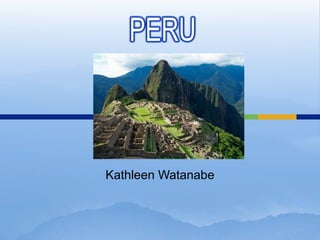
Peru nation report
- 2. •Official Name: Republic of Peru (República del Perú). •Short Name: Peru. •Capital: Lima. •Date of Independence: Declared July 28, 1821, from Spain; achieved, 1824. •Peru covers 496,225 square miles (1,285,216 km2). It borders Ecuador and Colombia to the north, Brazil to the east, Bolivia to the southeast, Chile to the south, and the Pacific Ocean to the west. •Peru is divided into 25 regions and the province of Lima.
- 3. •The Andes mountains run parallel to the Pacific shoreline dividing the country into three geographic regions. •The costa (coast) region is a narrow dry plains, except for valleys created by seasonal rivers. •The sierra (highlands) is made up of the Andes. The highest mountain is Huascarán at 6,768 m (22,205 ft). •The selva (jungle) is a wide area of flat terrain covered by the Amazon rainforest. Almost 60% of Peru is located within this region. •Unlike other countries in the equatorial region Peru does not have an exclusively tropical climate. The costa has moderate temperatures, low precipitation and high humidity. The sierra receives rain and snow. The selva has heavy rainfall and high temperatures and humidity.
- 4. •The population of Peru is approximately 29.5 million people. •It is multiethnic country of Amerindians, mestizos (of mixed ethnic descent), and people of African, European and Asian descent. •The primary language spoken is Spanish (83.9%). Several native languages are spoken of which 13.2% speak . •76% of the population live in urban areas and 24% in rural areas. •Roman Catholicism is the largest religion (81%) followed by Evangelical (12.5%).
- 5. •The literacy rate of Peru is estimated at 93% with the lower rates in the rural areas (80%) and higher rates in the urban areas (96%). •Primary and secondary education is compulsory. •Peru is a democratic republic. •The President is the head of state and is elected for a five-year term and can only seek re-election after standing down one full term. •The President appoints a Prime Minister and a Council of Ministers. •There is a unicameral Congress of 120 members elected for five-year terms.
- 6. •Peruvian culture is rooted in Amerindian and Spanish traditions. It is also influenced by African, Asian and European traditions. •Peruvian art includes pottery, textiles, jewelry and sculpture are rooted in Pre-Inca societies. •The Incas created the architectural marvel of Machu Picchu. •Peruvian literature is varied. It includes the oral traditions of pre-Columbian societies as well as varying genres introduced during the colonial period. •Peruvian cuisine is influenced by Amerindian and Spanish roots. African and Asian cultures have also influenced cuisine.
- 7. •Peruvian music is rooted in Amerindian, Spanish and African traditions.
- 8. •Amerindian civilizations date back over 10,000 years from descendants of the people who crossed over the Bering land bridge. •The Mochica civilization existed around the first millennium C.E. The built and elaborate irrigation system that transformed the coastal desert into productive agricultural lands. •In 1987 near Sipan, archaeologists discovered large numbers of elaborate artifacts of gold, silver and ceramics. •The Chimu civilization created many large cities from about 1150 to 1450. The capital, Chan Chan had an estimated 100,00 inhabitants.
- 9. •The Inca civilization began as a small Quechuas group and expanded from the thirteenth through the sixteenth centuries by conquering its neighbors. •The Inca civilization encompassed one-third of South America with a population of 9 to 16 million inhabitants. •The Spaniards under Francisco Pizarro arrived in 1532 and conquered the Incans. •The Spaniards also brought diseases that decimated the Inca population from 9 to 16 million inhabitants to 2.7 million by 1570. •Colonial Peru largely consisted of a modern, capitalistic and urban society and an Amerindian society of poverty, isolation and disease.
- 10. •The music of Peru is rooted in Peru's Andean musical roots and Spanish musical influences. •Native Peruvian music is played on the charango an instrument in the lute family similar to a mandolin. •Also played are the sikú (or zampoña) and antara. These are ancient indigenous instruments resembling panpipes. They are made of aquatic reeds found in many lakes in the Andean Region of South America.
- 11. •The sikú (or zampoña) and antara are ancient indigenous instruments resembling panpipes. They are made of aquatic reeds found in many lakes in the Andean Region of South America. •Other common instruments included the quena (a flute-like instrument) and the tinya (a type of drum).
- 12. •The most well known dance in Peru is the marinera. Other popular folk dances are the tondero and huayno.
- 14. REFERENCES Wikipedia, the Free Encyclopedia. Peru. Retrieved from http://en.wikipedia.org/wiki/Peru The Library of Congress. Country studies. Retrieved from http://lcweb2.loc.gov/frd/cs/cshome.html